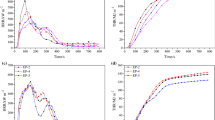Abstract
In the present work, the hexabromocyclododecane and the antimony trioxide were introduced into the bisphenol A epoxy resin to improve its flame retardancy. The effects of hexabromocyclododecane and antimony trioxide on flame retardancy of bisphenol A epoxy resin were estimated according to ASTM D2512-95 (2008). The specimen cured by T-31, with the addition of hexabromocyclododecane, did not show any flash and explosion during the 20 times of mechanical impact, whereas slightly empyreumatic scent was detected. The explosion was observed for the other specimens. The resin particles on the surface of the specimen after the mechanical impact were more than that before the mechanical impact, which was attributed presumably to the mechanical impact at the low temperature resulted in the crushing of the resin materials. It also indicated that bisphenol A epoxy resin cured by 593 with antimony trioxide at the low temperature had low flexibility. The XPS analysis confirmed that the surface of the specimen observed explosion was readily reacted with liquid oxygen. The O/C ratios of the specimen cured by T-31, with the addition of hexabromocyclododecane, before and after the mechanical impact were statistically approximate to 0.223 and 0.238, respectively, which revealed that the specimen was compatible with liquid oxygen.





Similar content being viewed by others
References
Hayaty M, Honarkar H, Beheshty MH (2013) Curing behavior of dicyandiamide/epoxy resin system using different accelerators. Iran Polym J 22:591–598
Wu XF, Wang Y, Xie LY, Yu JH, Liu F, Jiang PK (2013) Thermal and electrical properties of epoxy composites at high alumina loadings and various temperatures. Iran Polym J 22:61–73
Akbari R, Beheshty MH, Shervin M (2013) Toughening of dicyandiamide-cured DGEBA-based epoxy resins by CTBN liquid rubber. Iran Polym J 22:313–324
Wu ZJ, Gao F, Yan J, Wang Z (2012) Damage mechanism of polyphenylene sulfide resin in liquid oxygen. Iran Polym J 21:185–190
Robinson MJ, Stoltzfus JM, Owens TN (1997) Composite material compatibility with liquid oxygen. AIAA J 1107:973–982
Kim RY, Lee CW, Camping J, Bowman KB (2005) Impact reaction of composites in liquid oxygen. 46th AIAA/ASME/ASCE/AHS/ASC Struct Struct Dynam Mater Conf, 18–21 April, Austin, Texas
Clark AF, Hust JG (1974) A review of the compatibility of structural materials with oxygen. AIAA J 124:441–454
Wang G, Li XD, Yan R, Xing SL (2006) The study on compatibility of polymer matrix resins with liquid oxygen. Mater Sci Eng B 132:70–73
Yu L, Wang WJ, Xiao WD (2004) The effect of decabromodiphenyl oxide and antimony trioxide on the flame retardation of ethylene-propylene-diene copolymer/polypropylene blends. Polym Degrad Stab 86:69–73
Ema M, Fujii S, Hirata-Koizumi M, Matsumoto M (2008) Two-generation reproductive toxicity study of the flame retardant hexabromocyclododecane in rats. Reprod Toxicol 25:335–351
Lilienthal H, Van der Ven LTM, Piersma AH, Vos JG (2009) Effects of the brominated flame retardant hexabromocyclododecane (HBCD) on dopamine-dependent behavior and brainstem auditory evoked potentials in a one-generation reproduction study in Wistar rats. Toxicol Lett 185:63–72
Kuramoto K, Ehara M, Nakatsuji H, Kitajima M, Tanaka H, De Fanis A, Tamenori Y, Ueda K (2005) C 1s and O 1s photoelectron spectra of formaldehyde with satellites: theory and experiment. J Electron Spectrosc Relat Phenom 142:253–259
Colmenares JC, Kijenski J, Arévalo-García EB (2009) Chemical trapping studies to the determination of surface species under reaction conditions for the catalytic side-chain oxidative alkylation of toluene by methane. J Mol Catal A Chem 309:21–27
Liu SJ, Zhou F, Di DL, Jiang SX (2004) Surface-confined radical chain transfer. The intermediate reaction for chemically attaching polymer films on porous silica for chromatographic application. Colloid Surf A 244:87–93
Acknowledgments
This work was supported by Fundamental Research Funds for the Central Universities (DUT10ZDG05) and the National Natural Science Foundation of China (51102031, 51002019 and 91016024).
Author information
Authors and Affiliations
Corresponding author
Rights and permissions
About this article
Cite this article
Li, J., Li, S., Wang, M. et al. Effect of hexabromocyclododecane and antimony trioxide on flame retardancy of bisphenol A epoxy resin. Iran Polym J 22, 903–910 (2013). https://doi.org/10.1007/s13726-013-0190-y
Received:
Accepted:
Published:
Issue Date:
DOI: https://doi.org/10.1007/s13726-013-0190-y




